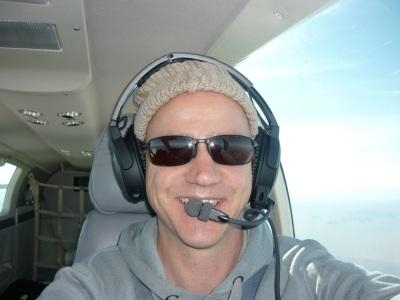Hopes To Set Two Records With The Attempt
Australian pilot Jeremy Rowsell hopes to set off on a record breaking flight from Sydney to London in a single engine aircraft powered 100 per cent by fuel made from plastic waste – an interesting journey that he somewhat immodestly claims "could change the face of the aviation industry." Rowsell (pictured) will fly a Cessna 182 solo, cruising mainly at 5,000 feet, sometimes in 13 hour stretches, along the same route used by the barnstorming pilots of the 1920s and 1930s.

He will attempt to better two records. First, a record flight time from Sydney to London for the aircraft type and second, to be the first pilot to fly an aircraft using a synthetic fuel derived from end of life plastic waste bio fuel as a single source of power. The project called ‘On Wings of Waste’ came about after he reportedly witnessed first hand from the air, pollution on land and sea, and recognised the significant danger posed by ever increasing plastic waste.
His concern about the environment and 'the consequences of an aviation industry reliant on toxic and damaging fuels' is reportedly what has inspired this effort. “Flying is critical to the economy, vital for saving lives and is the best way to experience the planet we live on. We can’t stop flying, but how can we do that and do it sustainably?” said Rowsell, who was born in London but now lives in Sydney.
“Our world is choking on human, plastic waste. In the middle of the Pacific Ocean is the Great Pacific Garbage Patch – a mire of plastic waste spanning millions of square kilometres. If it were a country, it would be one of the biggest on the planet.” he added.
The discovery of an Irish company that takes end of life plastic waste, destined for landfill or possibly the ocean, and distills it into liquid fuel, was the catalyst for the project. Although recognised as a technical marvel, the fuel produced by a company called Cynar PLC, has never been tested in the air. “Our objective is to prove that this synthetic fuel made from plastic waste is viable for a number of practical solutions and by doing so replace the need to use fossil fuels from conventional sources. What better way to showcase this then via aviation – an industry that is looking to diesel fuel to provide a solution to the problems it faces with current avgas fuels that are costly and environmentally damaging.”
“Aviation leads technology in many instances, why not do it once again with this fuel? If this plan works it would solve some major environmental problems all at once.” Rowsell explained.

Step two was to put together a team including international risk and survival specialist Tony Loughran and project manager Tarsha Burn, who is in charge of the strategic and tactical planning, sponsorship and production. The pilot reports that he has been put through 'rigorous tests' (though we're not sure what's so rigorous about flying a Cessna 182--Ed.).
Heavy on hyperbole, Rowsell claims that flight 'will test his physical and mental endurance to the limit.' In 2011 Roswell flew the Pacific to re-trace the epic flight endeavour of Sir Charles Kingsford Smith in a tiny single engine aircraft, to raise money for the Royal Flying Doctor Service, so he is no stranger to perilous aerial adventure.
The plastic fuel has been tested in cars and is being tested to work in diesel powered aeroplanes. The airports where he stops will need to store this fuel to allow for the continuation of the flight. He plans to take off from Sydney later this year to fly more than 10,000 nautical miles and will chase a record time set by the pioneers.
Stopping en route in Darwin, Christmas Island, Sri Lanka, Oman, Jordan and Malta, he is expected to arrive in London after six days of flying.
Rowsell will update his progress through advanced satellite technology, including data communication tools from his aircraft and he claims that the trip will result in a documentary film.
(Rowsell photo provided by Richard Peel Public Relations. Skylane photo from file)
 Aero-TV: DeltaHawks Diesel Power Steps Into the Spotlight
Aero-TV: DeltaHawks Diesel Power Steps Into the Spotlight NTSB Prelim: Mooney Aircraft Corp. M20K
NTSB Prelim: Mooney Aircraft Corp. M20K ANN FAQ: Turn On Post Notifications
ANN FAQ: Turn On Post Notifications ANN's Daily Aero-Linx (12.20.25)
ANN's Daily Aero-Linx (12.20.25) Aero-News: Quote of the Day (12.20.25)
Aero-News: Quote of the Day (12.20.25)




